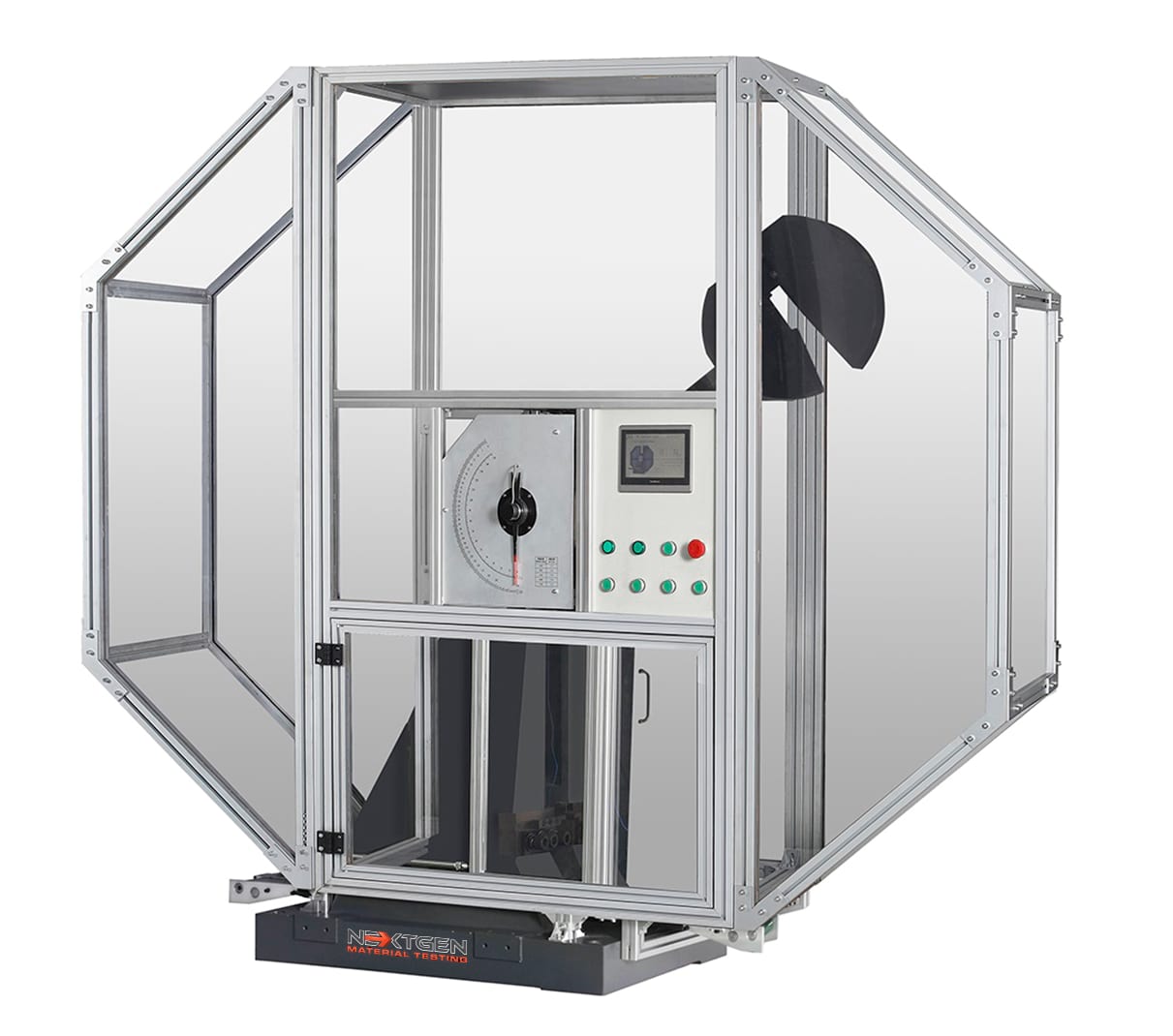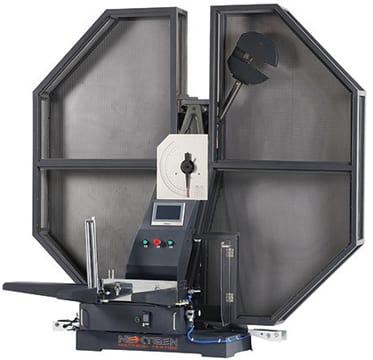Charpy vs. Izod Impact Testing
Selecting an Impact Tester Provider

The Charpy and Izod tests are two well-known methods for studying the toughness of materials. Many industries use either of the two for testing material strength. The tests measure the amount of energy absorbed by a notched sample when it gets hit by a weighted pendulum. The computed energy serves as a measure of the specimen’s toughness.
Testers use a pendulum impact testing machine to perform the Charpy or the Izod impact test.
A pendulum impact testing machine or a pendulum impact tester is an apparatus with a swinging pendulum that gets released to impact a secured specimen. The pendulum has a weighted hammer at its end, which hits the sample material.
Specimens for impact testing can be metals, metallic alloys, or plastic materials.
The specimen will either have a V or a U shaped notch in it. Specimens may get deformed if there are no notches in them. There may also be inconsistencies in the test results when there are no notches in the material.
Testers use a broaching machine or a notch cutter to make the notches on the sample material. The depth for a V shaped notch is 2mm deep and 5mm deep for a U shaped notched specimen.
Materials are often heated up or cooled down before testing. This is for testing specimens exposed at different temperatures. The specimens may undergo a series of tests at specific temperatures. Sometimes, test results are the average of five specimens.
To perform the impact test, the operator first raises and locks the pendulum at a fixed height. The tester then places the specimen on a support in the striking anvil. Tester makes sure that the specimen is well secured.
An indicator or dial is then reset. After some safety checks, the tester releases the pendulum to impact the specimen. The tester can use a heavier hammer if there is no breakage.
After impact, the tester computes the energy absorbed by the material. This is the difference between the height of the pendulum at the start and its height after the impact blow.
The Charpy impact test is still one of the most popular impact test methods. The main reason for this is because samples for the test are easy to prepare. Results are also very easy to compute.
The equipment for the Izod impact and Charpy tester are almost identical. But, there are differences such as the orientation of the material in the impact tester.
Following are the primary differences between the two tests:
Position of the Sample Material
In the Charpy impact test, the sample lies flat on the test bed as a simple beam. Both ends of the specimen get secured before the moment of impact.
In the Izod impact test, the sample is in a vertical cantilevered position. Only the bottom end of the specimen gets locked in place. The pendulum hammer strikes the unlocked end of the specimen at a specific point.
Notch Facing
For the Charpy tester, the notch is facing away from the pendulum arm. In the Izod impact test, the notch is facing the pendulum.
Type of Notches
All the stress from the impact gets concentrated on the notched section. Specimens break at the notched portions.
Specimens for the Pendulum Charpy impact tester can have a V or a U shaped notch.
Specimens for the Pendulum Izod impact tester only have V notches in them.
For Izod impact tests, specimens can have up to three V notches. This configuration is best for doing tests that involve some averaging. The material gets broken one at a time for this type of test. Charpy test specimens only have one notch in the middle.
Point of Impact
For the Charpy impact test, the hammer strikes the middle part of the specimen.
For the Izod impact test, the hammer strikes the specimen at a certain point above the notch.
Striking Hammer Type
Older Charpy machines have a rounded hammer pin.
The Izod impact testing machine uses a farming hammer styled striker.
Type of Specimens
Charpy impact tests are for steel products. Izod impact tests are for metallic and plastic specimens.
Specimen Dimensions
The basic specimen size for Izod tests is 63.5 x 12.7 x 3.2 mm bar (for plastics) and 127 x 11.43 mm (round metal bar)
The standard specimen size for Charpy tests is 10 mm x 10 mm x 55 mm (metal bar)
Modern Charpy machines can test for multiple specimens. A tower magazine holds the specimens while moving along a motor conveyor belt.
A Charpy impact test must conform to ASTM A370 standards. ASTM A370 covers a set of procedures for testing steel products. Besides impact test specifications, the standard also includes testing definitions for tension, bend and hardness.
An ASTM A370 Charpy Impact test involves instructions for testing steel. Stainless steel and other alloy products are also covered by the ASM A370.
There are other standards besides ASTM A370 that testing procedures should adhere to.
ASTM E23 describes test methods for both Charpy and Izod testing of notched bar samples. Izod impact tests should conform to ASTM D256 specifications. ASTM D256 covers test methods that determine impact resistance for plastics.
Material Testing Provider

NextGen Material Testing, Inc. is one of the leading manufacturers of pendulum impact testers. They have one of the most advanced Charpy Impact Tester for sale. The company offers equipment that tests tension and metal hardness. They also have machines for testing rubber and plastic.
The company does not have a sole Izod Impact Tester for sale. But they have one designed for both Charpy and Izod impact testing. They have a couple of Charpy testing equipment with advanced features as well.
NextGen Material Testing, Inc. provides high quality equipment at a lower cost. One of the reasons they are able to achieve this is because of the groundwork that the company has set.
Another reason is that they have eliminated the middle man from the picture. Because of these, the company is able to maintain a high production volume with low overhead. The company also offers services and product training to its customers.
The Impact testers that NextGen Material Testing, Inc. offers have the latest software installed in them. This advanced software makes it easier for personnel to operate the equipment.
The NextGen Electromechanical TestPilot Control Software has the following features.
- It comes with a library of pre-packaged test methods (ASTM, ISO, DIN, EN, BS, etc.). This helps the operator meet requirements of industry test standards.
- User authorization to help authenticate users of the machine. Users can be lab managers, technicians and operators.
- Intuitive user interface design. The interface is user-friendly.
- Real-time data display with graphs on the same screen. This is useful for studying several events during testing.
- Offers test curve analysis with easy to understand displays. Operators can zoom in, inspect and manipulate markers on graphs.
- Other accessories are easy to calibrate and verify.
- Provides operators capability to change hardware parameters
- Users get to select the appropriate the S! Measurements needed for the test. Testers can also define their own formulas depending on the test requirements.
- Produces standard test report output, or customized reports. It is also capable of exporting test results to MS Word or Excel.
Learn more about the right Impact Testing Machine for your laboratory by calling or submitting request.